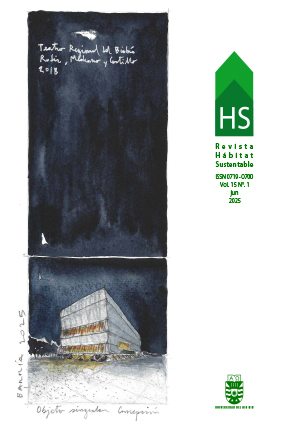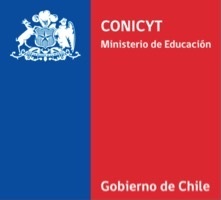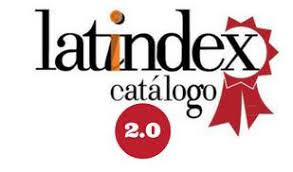Impacto da morfologia dos bairros em climas tropicais: um estudo de caso dos bairros tradicionais de Kanyakumari, Índia
DOI:
https://doi.org/10.22320/07190700.2025.15.01.02Palavras-chave:
morfologia, área residencial, clima, zonas tropicaisResumo
A morfologia do ambiente construído interage com o ambiente térmico circundante. As interações térmicas afetam a demanda energética e o conforto térmico de um bairro. As temperaturas extremas decorrentes das mudanças climáticas exigem intervenções que repercutem no aquecimento urbano. Assim, este estudo analisou a interação térmica entre a morfologia e o entorno térmico. O estudo foi realizado na cidade tropical de Kanyakumari, localizada na Índia. Foi estudada a influência da relação de aspecto, do fator de vista do céu, da relação de cobertura verde e da relação de cobertura dos edifícios no Índice Climático Térmico Universal. Realizou-se uma análise quantitativa das variáveis morfológicas para estabelecer uma relação com a variável de conforto. As proporções de aspecto e cobertura verde correlacionaram-se positivamente com o índice climático. Em contrapartida, o fator de vista do céu e a proporção de cobertura dos edifícios tiveram uma relação negativa com o índice. No entanto, com a introdução de vegetação nas ruas, a interação entre a proporção de aspecto e o índice foi invertida em áreas onde um aumento na relação de aspecto costumava reduzir o conforto no cânion.
Downloads
Referências
BETTI, G., TARTARINI, F., NGUYEN, C., & SCHIAVON, S. (2024). CBE Clima Tool: a free and open-source web application for climate analysis tailored to sustainable building design. Building Simulation, 17(3), 493-5008. https://doi.org/10.1007/s12273-023-1090-5 DOI: https://doi.org/10.1007/s12273-023-1090-5
BOUKHABLA, M., ALKAMA, D., & BOUCHAIR, A. (2013). The effect of urban morphology on urban heat island in the city of Biskra in Algeria. International Journal of Ambient Energy, 34(2), 100–110. https://doi.org/10.1080/01430750.2012.740424 DOI: https://doi.org/10.1080/01430750.2012.740424
Bureau of Energy Efficiency. (2023). Impact of Energy Efficiency Measures For The Year 2021-22. https://udit.beeindia.gov.in/wp-content/uploads/2024/02/Impact-Assessment-Report-2021-22-1.pdf
CHEN, G., WANG, D., WANG, Q., LI, Y., WANG, X., HANG, J., GAO, P., OU, C., & WANG, K. (2020). Scaled outdoor experimental studies of urban thermal environment in street canyon models with various aspect ratios and thermal storage. Science of the Total Environment, 726, 138147. https://doi.org/10.1016/j.scitotenv.2020.138147 DOI: https://doi.org/10.1016/j.scitotenv.2020.138147
CHEN, S., ZHANG, W., HIEN, N., & IGNATIUS, M. (2020). Combining CityGML files and data-driven models for microclimate simulations in a tropical city. Building and Environment, 185, 107314. https://doi.org/10.1016/j.buildenv.2020.107314 DOI: https://doi.org/10.1016/j.buildenv.2020.107314
DE, B., & MUKHERJEE, M. (2018). "Optimisation of canyon orientation and aspect ratio in warm-humid climate: Case of Rajarhat Newtown, India". Urban Climate, 24, 887–920. https://doi.org/10.1016/j.uclim.2017.11.003 DOI: https://doi.org/10.1016/j.uclim.2017.11.003
EMMANUEL, R., & FERNANDO, H. J. S. (2007). Urban heat islands in humid and arid climates: Role of urban form and thermal properties in Colombo, Sri Lanka, and Phoenix, USA. Climate Research, 34, 241–251. https://doi.org/10.3354/cr00694 DOI: https://doi.org/10.3354/cr00694
EMMANUEL, R., & JOHANSSON, E. (2006). Influence of urban morphology and sea breeze on hot humid microclimate: The case of Colombo, Sri Lanka. Climate Research, 30, 189–200. https://doi.org/10.3354/cr030189 DOI: https://doi.org/10.3354/cr030189
GOLANY, G. S. (1996). Urban design morphology and thermal performance. Atmospheric Environment, 30(3), 455–465. https://doi.org/10.1016/1352-2310(95)00266-9 DOI: https://doi.org/10.1016/1352-2310(95)00266-9
JAMEI, E., OSSEN, D. R., SEYEDMAHMOUDIAN, M., SANDANAYAKE, M., STOJCEVSKI, A., & HORAN, B. (2020). Urban design parameters for heat mitigation in tropics. Renewable and Sustainable Energy Reviews, 134, 110362. https://doi.org/10.1016/j.rser.2020.110362 DOI: https://doi.org/10.1016/j.rser.2020.110362
JASP Team. (2024). JASP (Version 0.19.2) [Computer software]. https://jasp-stats.org/
JOHANSSON, E., EMMANUEL, R., & ROSENLUND, H. (September 19–22 2004). Microclimate and thermal comfort in the warm humid city of Colombo, Sri Lanka. Plea2004 - The 21th Conference on Passive and Low Energy Architecture. Eindhoven, The Netherlands. https://alexandria.tue.nl/openaccess/635611/p0661final.pdf
JUSUF, S. K., & HIEN, W. N. (2012). Development of empirical models for an estate-level air temperature prediction in Singapore. Journal of Heat Island Institute International, 7-2, 111-125. https://heat-island.jp/web_journal/HI2009Conf/pdf/15.pdf
KRÜGER, E., & GIVONI, B. (2007). Outdoor measurements and temperature comparisons of seven monitoring stations: Preliminary studies in Curitiba, Brazil. Building and Environment, 42(4), 1685–1698. https://doi.org/10.1016/j.buildenv.2006.02.019 DOI: https://doi.org/10.1016/j.buildenv.2006.02.019
LASSANDRO, P., DI TURI, S., & ZACCARO, S. A. (2019). Mitigation of rising urban temperatures starting from historic and modern street canyons towards zero energy settlement. IOP Conference Series: Materials Science and Engineering, 609(7), 072036. https://doi.org/10.1088/1757-899X/609/7/072036 DOI: https://doi.org/10.1088/1757-899X/609/7/072036
NBC. (2016). National Building Code of india 2016 Volumen 2. Bureau of Indian Standards. https://dn790000.ca.archive.org/0/items/nationalbuilding02/in.gov.nbc.2016.vol2.digital.pdf
OKE, T. R. (1982). The energetic basis of the urban heat island. Quarterly Journal of the Royal Meteorological Society, 108(455), 1–24. https://doi.org/10.1002/qj.49710845502 DOI: https://doi.org/10.1002/qj.49710845502
OKE, T. R., JOHNSON, G. T., STEYN, D. G., & WATSON, I. D. (1991). Simulation of surface urban heat islands under “ideal” conditions at night, part 2: Diagnosis of causation. Boundary-Layer Meteorology, 56, 339–358. https://doi.org/10.1007/BF00119211 DOI: https://doi.org/10.1007/BF00119211
OUYANG, W., LIU, Z., LAU, K., SHI, Y., & NG, E. (2022). Comparing different recalibrated methods for estimating mean radiant temperature in outdoor environment. Building and Environment, 216, 109004. https://doi.org/10.1016/j.buildenv.2022.109004 DOI: https://doi.org/10.1016/j.buildenv.2022.109004
PATTACINI, L. (2012). Climate and urban form. Urban Design International, 17, 106–114. https://doi.org/10.1057/udi.2012.2 DOI: https://doi.org/10.1057/udi.2012.2
SHAFAGHAT, A., MANTEGHI, G., KEYVANFAR, A., BIN LAMIT, H., SAITO, K., & OSSEN, D. R. (2016). Street geometry factors influence urban microclimate in tropical coastal cities: A review. Environmental and Climate Technologies, 17(1), 61–75. https://doi.org/10.1515/rtuect-2016-0006 DOI: https://doi.org/10.1515/rtuect-2016-0006
SHANKAR, M., & MARWAHA, B. M. (2023). Impact of courtyard on indoor thermal environment in vernacular row houses of warm and humid climate: case study of Kanyakumari, Tamil Nadu. Advances in Building Energy Research, 17(6), 653–678. https://doi.org/10.1080/17512549.2023.2290529 DOI: https://doi.org/10.1080/17512549.2023.2290529
SHANKAR, M., & SUNDARAM, A. M. (2023). Efficient and optimum design of native architecture – A means for sustainability. Case study of Residential Units in Kottar, Kanyakumari. Energy & Buildings, 298, 113586. https://doi.org/10.1016/j.enbuild.2023.113586 DOI: https://doi.org/10.1016/j.enbuild.2023.113586
SHARMIN, T., STEEMERS, K., & HUMPHREYS, M. (2019). Outdoor thermal comfort and summer PET range: A field study in tropical city Dhaka. Energy and Buildings, 198, 149–159. https://doi.org/10.1016/j.enbuild.2019.05.064 DOI: https://doi.org/10.1016/j.enbuild.2019.05.064
SUN, C. Y. (2011). A street thermal environment study in summer by the mobile transect technique. Theoretical and Applied Climatology, 106, 433–442. https://doi.org/10.1007/s00704-011-0444-6 DOI: https://doi.org/10.1007/s00704-011-0444-6
TSOKA, S., TSIKALOUDAKI, K., & THEODOSIOU, T. (2017). Urban space’s morphology and microclimatic analysis: A study for a typical urban district in the Mediterranean city of Thessaloniki, Greece. Energy and Buildings, 156, 96–108. https://doi.org/10.1016/j.enbuild.2017.09.066 DOI: https://doi.org/10.1016/j.enbuild.2017.09.066
TSOKA, S., TSIKALOUDAKI, K., THEODOSIOU, T., & BIKAS, D. (2020). Assessing the effect of the urban morphology on the ambient air temperature of urban street canyons under different meteorological conditions. Application in residential areas of Thessaloniki, Greece. IOP Conference Series: Earth and Environmental Science, 410, 012005. https://doi.org/10.1088/1755-1315/410/1/012005 DOI: https://doi.org/10.1088/1755-1315/410/1/012005
VANOS, J. K., RYKACZEWSKI, K., MIDDEL, A., VECELLIO, D. J., BROWN, R. D., & GILLESPIE, T. J. (2021). Improved methods for estimating mean radiant temperature in hot and sunny outdoor settings. International Journal of Biometeorology, 65, 967–983. https://doi.org/10.1007/s00484-021-02131-y DOI: https://doi.org/10.1007/s00484-021-02131-y
YU, Z., CHEN, S., WONG, N. H., IGNATIUS, M., DENG, J., HE, Y., & HII, D. J. C. (2020). Dependence between urban morphology and outdoor air temperature: A tropical campus study using random forests algorithm. Sustainable Cities and Society, 61, 102200. https://doi.org/10.1016/j.scs.2020.102200 DOI: https://doi.org/10.1016/j.scs.2020.102200
ZHOU, H., TAO, G., YAN, X., & SUN, J. (2021). Influences of greening and structures on urban thermal environments: A case study in Xuzhou City, China. Urban Forestry and Urban Greening, 66, 127386. https://doi.org/10.1016/j.ufug.2021.127386 DOI: https://doi.org/10.1016/j.ufug.2021.127386
ZHU, S., CHEN, M., LU, S., & MAI, X. (2022). Influence of Urban Geometry on Thermal Environment of Urban Street Canyons in Hong Kong. Buildings, 12(11), 1836. https://doi.org/10.3390/buildings12111836 DOI: https://doi.org/10.3390/buildings12111836
Downloads
Publicado
Como Citar
Edição
Secção
Licença
Direitos de Autor (c) 2025 Monika Shankar, A. Meenatchi Sundaram

Este trabalho encontra-se publicado com a Licença Internacional Creative Commons Atribuição-CompartilhaIgual 4.0.
O conteúdo dos artigos publicados em cada número do Habitat Sustentável é da exclusiva responsabilidade dos autores e não representa necessariamente o pensamento ou compromete a opinião da Universidad del Bío-Bío.
Os autores mantêm os seus direitos de autor e concedem à revista o direito de primeira publicação da sua obra, que está simultaneamente sujeita à Licença de Atribuição Creative Commons CC BY-SA que permite a outros partilhar, transformar ou criar novo material a partir desta obra para fins não comerciais, desde que a autoria e a primeira publicação nesta revista sejam reconhecidas, e as suas novas criações sejam licenciadas sob os mesmos termos.











 Programa de Informação Científica/Concurso Fondos de Publicación de Revistas Científicas 2018/ Proyecto Mejoramiento de Visibilidad de Revistas UBB (Código:FP180007)
Programa de Informação Científica/Concurso Fondos de Publicación de Revistas Científicas 2018/ Proyecto Mejoramiento de Visibilidad de Revistas UBB (Código:FP180007)





